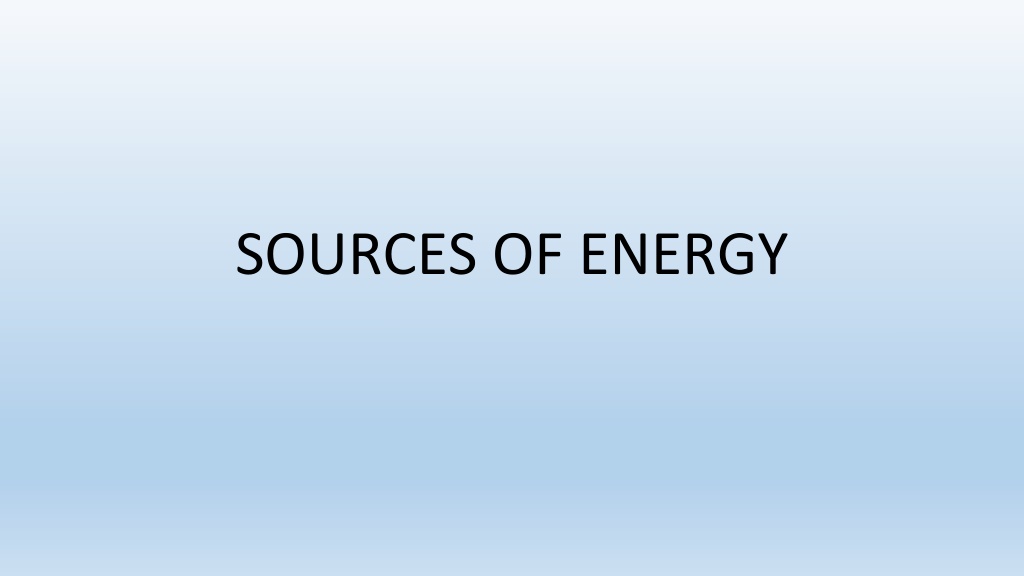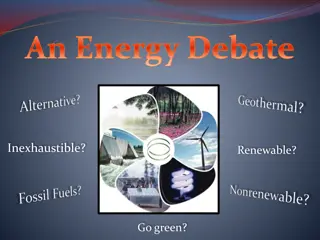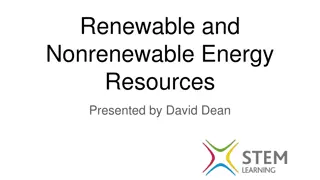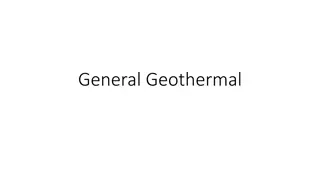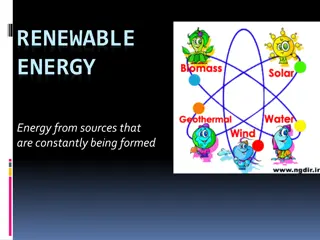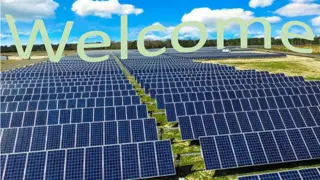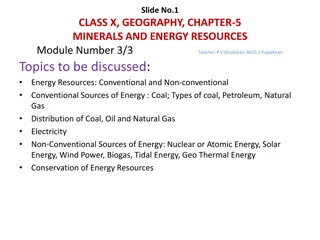Understanding Different Sources of Energy
Exploring conventional and non-conventional sources of energy, this content discusses the characteristics of a good fuel source, such as high energy output and ease of availability. It delves into the distinction between renewable and non-renewable energy sources, highlighting fossil fuels as non-renewable and emphasizing the need for conservation due to their environmental impact. Specific examples like thermal power plants, hydroelectric power, and biomass energy are outlined, detailing their advantages and disadvantages.
Download Presentation

Please find below an Image/Link to download the presentation.
The content on the website is provided AS IS for your information and personal use only. It may not be sold, licensed, or shared on other websites without obtaining consent from the author. Download presentation by click this link. If you encounter any issues during the download, it is possible that the publisher has removed the file from their server.
E N D
Presentation Transcript
Characteristics of a good source of fuel :- i) It should have a high energy output per unit mass or volume. ii) It should be easily available. iii) It should be easy to store and transport. iv) It should be economical. Sources of energy :- There are two main sources of energy. They are conventional and non conventionalsources of energy. i) Conventional sources of energy :- are wood, flowing water and fossil fuels (coal,petroleum, natural gas). ii) Non conventional sources of energy :- are solar energy, wind energy, biomass energy, ocean energy (tidal energy, wave energy, ocean thermal energy), geothermal energy, nuclearenergy etc. Some sources of energy are renewable like sun, wind, flowing water, ocean, wood,biomass etc. Some sources of energy are non renewable like coal, petroleum and natural gas.
. Conventional sources of energy Fossil fuels :- are fuels formed inside the earth from the remains of plants and animals after millions of years. The fossil fuels are coal, petroleum and natural gas. Fossil fuels are non renewable sources of energy so they should be conserved and used judiciously. Disadvantages of fossil fuels :- i) Burning of fossil fuels release gases and harmful particles which causes air pollution. ii) Burning of fossil fuels release acidic oxides of sulphur and nitrogen which causes acid rain which is harmful for living organisms, affects soil and water, causes damage to buildings, corrosion of metals etc. iii) Burning of fossil fuels release a large amount of carbon dioxide gas which increases the temperature of the atmosphere and causes global warming (green house effect).
b) Thermal power plants :- In thermal power plants the heat energy produced by burning fossil fuels like coal, petroleum or natural gas is used to heat water and change it into steam which rotates the turbines of generators to produce electricity. c) Hydro power plants :- In hydro power plants water from rivers are stored by constructing dams. The water from the dam flows down through pipes and rotates the turbines of generators to produce electricity. Advantages :- i) Flowing water is a renewable source of energy. ii) The electricity produced does not cause pollution. iii) The water stored in dams can also be used to control floods and for irrigation. Disadvantages :- i) The initial cost is high. ii) Large areas of land gets submerged and the decomposition of vegetation produces methane gas which is a green house gas iii) It causes displacement of people from large areas of land.
d) Biomass energy :- The waste materials and dead parts of living things are called biomass. Eg :- wood, animal dung, vegetable waste, agricultural waste, sewage etc. Biomass is decomposed by anaerobic microorganisms to produce biogas. Biogas is a mixture of gases containing methane, carbon dioxide, hydrogen and hydrogen sulphide. Biogas plant :- The biogas plant has a large underground tank made of bricks and cement. The lower part is the digester and the upper part has a dome with a gas outlet. On one side of the tank above the ground is a mixingtank and on the other side is an overflow tank. Animal dung is mixed with water in the mixing tank and the slurry is sent into the digester. In the digester the slurry is decomposed by anaerobic microorganisms and after a few days biogas is produced. The gas is taken out through the gas outlet and used for heating and lighting purposes. The slurry left behind is rich in nitrogen and phosphorus and is used as manure for crops.
e) Wind energy :- Wind energy is used in wind mills which converts the kinetic energyof the wind into mechanical or electrical energy. The kinetic energy ofwind can be used to do mechanical work like lifting water from wellsor grinding grains in flour mills. It can also be used to rotate theturbines of generators to produce electricity. A single wind mill produces only a small amount of electricity. So alarge number of wind mills in a large area are coupled together toproduce more electricity in wind energy farms. Advantages :- i) It is a renewable source of energy. ii) It does not cause pollution. iii) The recurring cost is less. Disadvantages :- i) Wind is not available at all times. ii) It requires a large area of land. iii) A minimum wind speed of 15 km/h is required.
4) Non conventional sources of energy :- a) Solar energy :- Solar energy is the energy obtained from the sun in the form of heat and light. The heat energy is used in solar heating devices like solar cooker, solar water heater, solar furnaces etc. The light energy is used in solar cells. i) Solar cooker :- The box type solar cooker has an insulated box painted black inside. It is covered by a glass plate which allows heat to enter inside but does not allow heat to escape out. It has a mirror to reflect more sunlight into the box. The food to be cooked is kept in containers inside the box It can produce a temperature of 100 to140 . ii) Solar water heater :- A solar water heater has an insulated box painted black inside with a system of copper tubes. It is covered with a glass plate which allows heat to enter inside but does not allow heat to escape out. When water flows through the copper tube it absorbs heat and becomes hot.
iii) Solar cells :- Solar cell is a device which converts solar energy into electrical energy. Solar cells are made from semi conductors like silicon, germanium, gallium etc. A single solar cell produces a voltage of about 0.5 to 1V and produces about 0.7 W electricity. So several solar cells are arranged in a solar panel to produce more electricity. Advantages :- i) It uses renewable source of energy. ii) It produces electricity which does not cause pollution. iii) It can be used in remote areas where there is no power supply. Disadvantages :- i) It uses a special grade of silicon which is expensive. ii) Since silver is used for connecting the cells together it is more expensive. iii) The current produced is DC and to convert it to AC increases thecost.
b) Energy from the sea :- Energy from the sea is obtained in three different forms. They are Tidal energy, Sea wave energy and Ocean thermal energy. i) Tidal energy :- The periodic rise and fall of sea level due to gravitational attraction of the moon causes tides. A dam is constructed at a narrow opening between the land and sea. The movement of water during high tide and low tide can be used to rotate the turbines of generators to produce electricity. ii) Sea wave energy :- When strong wind blows over the sea it produces huge waves. The kinetic energy of the moving waves can be used to rotate the turbines of generators to produce electricity. iii) Ocean thermal energy :- There is a temperature difference between the warm surface water and the cold water at the bottom of the oceans. This difference is about 20 C. The warm surface water is used to boil liquid ammonia and the vapour is used to rotate the turbines of generators to produce electricity. The cold water from the bottom is then pumped up to cool the vapour back to liquid.
d) Nuclear energy :- Nuclear energy is the energy is the energy released during nuclear reactions. During nuclear reactions some mass is converted into energy and so a very large amount of energy is produced during nuclear reactions. Nuclear reactions are of two types. They are Nuclear fission and nuclear fusion. i) Nuclear fission :- is a nuclear reaction in which the nucleus of a heavy atom like uranium, plutonium, etc. splits into smaller nuclei with the release of a large amount of energy. It is used to make atom bombs and to produce electricity. In a nuclear power plant the heat energy produced by a controlled nuclear fission chain reaction is used to produce steam which rotates the turbines of generators to produce electricity. ii) Nuclear fusion :- is a nuclear reaction in which small nuclei fuse together to form a heavier nucleus with the release of a very large amount of energy. The energy of sun is produced by the fusion of hydrogen nuclei to form helium nucleus. It is also used to make the hydrogen bomb. Advantages of nuclear energy :- i) It produces a very large amount of energy per unit mass than any other source of energy. ii) If safety measures are taken, it is more environment friendly than fossil fuels. Disadvantages of nuclear energy :- i) The cost of a nuclear reactor is very high. ii) The availability of nuclear fuel is limited. iii) Nuclear reactors produce harmful nuclear wastes which is difficult to dispose.
